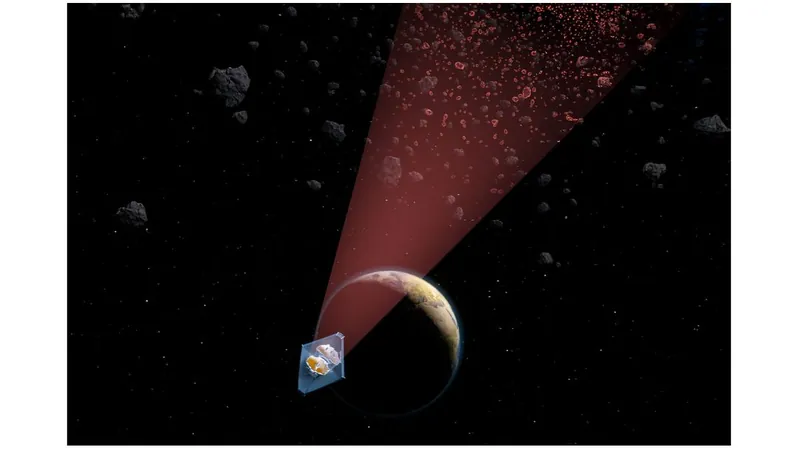
Groundbreaking Discovery: James Webb Space Telescope Unveils the Tiniest Asteroids in Our Solar System!
2024-12-10
Author: Jacques
Introduction
In an astonishing advancement, astronomers utilizing the James Webb Space Telescope (JWST) have identified an incredible array of minuscule asteroids, including the smallest ever detected within the main asteroid belt nestled between Mars and Jupiter. This remarkable finding not only expands our understanding of these cosmic bodies but also poses significant implications for planetary defense.
Significance of Smaller Asteroids
The focus on smaller asteroids is crucial, as it is often the smaller chunks of rock—sometimes only tens of meters across—that pose a significant threat to Earth. Though not the massive planet-destroyers of blockbuster films, these diminutive asteroids can still unleash devastation on a local scale, potentially wreaking havoc on entire cities. Research indicates that these smaller asteroids are far more abundant than their larger counterparts, and their paths can be easily influenced, nudging them closer to Earth. This raises concerns that the next hazardous object, like the infamous Chelyabinsk meteor or the Tunguska event, might approach with little to no warning.
Challenges in Detection
Artem Burdanov, a leading planetary scientist from the Massachusetts Institute of Technology (MIT), remarked, 'While we have successfully tracked near-Earth asteroids down to sizes of about 10 meters when they are relatively near to our planet, spotting them out in the main asteroid belt—located 112 million miles (180 million kilometers) away—has historically been a challenge.' Until now, the smallest asteroid observed was around a kilometer wide.
Groundbreaking Discovery of a Small Asteroid
Burdanov and his colleagues made a groundbreaking discovery by detecting a minute 33-foot-wide (10-meter) asteroid using JWST data originally aimed at investigating the atmospheres of rocky exoplanets surrounding the red dwarf star TRAPPIST-1. This achievement marks a turning point in our ability to monitor these smaller bodies from a distance, enhancing our capability for orbital tracking vital for planetary defense strategies.
Methodology of Detection
To pinpoint these asteroids, astronomers had to sift through an overwhelming volume of data, filtering out noise from various cosmic distractions. By stacking multiple images of the same section of sky, they enhanced the visibility of the target objects. Each asteroid appeared as a fleeting pinprick of infrared light against the backdrop of a galaxy, maintaining a different trajectory compared to stationary targets like TRAPPIST-1.
Results and Implications
Burdanov's team painstakingly examined 10,000 images searching for those elusive smudges of light that indicated the presence of asteroids. Their efforts bore fruit, leading to the identification of an impressive 138 previously undetected asteroids, varying in size from 10 meters to several hundred meters.
Significance of the Findings
Co-author Julien de Wit acknowledged the significance of their findings, stating, 'We initially anticipated uncovering just a handful of new objects, yet our results exceeded all expectations, particularly regarding the number of smaller asteroids. This indicates we are tapping into a new phase of research where we uncover numerous small objects generated through the cascade of collisions that effectively break down larger asteroids.'
Conclusion
'This is a pioneering venture into previously unexplored territory made possible by modern technological advancements,' Burdanov concluded. 'It clearly exemplifies how re-examining data can yield substantial results, highlighting the thrilling potential of our ongoing explorations in the cosmos.' With the JWST leading the charge, the astronomical community is poised for further groundbreaking discoveries. Stay tuned as we continue to unveil the mysteries of our solar system and beyond!



 Brasil (PT)
Brasil (PT)
 Canada (EN)
Canada (EN)
 Chile (ES)
Chile (ES)
 Česko (CS)
Česko (CS)
 대한민국 (KO)
대한민국 (KO)
 España (ES)
España (ES)
 France (FR)
France (FR)
 Hong Kong (EN)
Hong Kong (EN)
 Italia (IT)
Italia (IT)
 日本 (JA)
日本 (JA)
 Magyarország (HU)
Magyarország (HU)
 Norge (NO)
Norge (NO)
 Polska (PL)
Polska (PL)
 Schweiz (DE)
Schweiz (DE)
 Singapore (EN)
Singapore (EN)
 Sverige (SV)
Sverige (SV)
 Suomi (FI)
Suomi (FI)
 Türkiye (TR)
Türkiye (TR)
 الإمارات العربية المتحدة (AR)
الإمارات العربية المتحدة (AR)